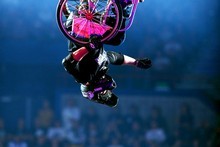Assistive technology is equipment that assists people with their activities. It includes technology that contributes to the persute of leisure,work and daily living. It is a regular, reliable, repeatable peice of equipment that doesn't cause fatigue. This may also cover technology that is used by the able bodied person or child along with the disabled. "Assistive technology is technology used by individuals with disabilities in order to perform functions that might otherwise be diffcult or possible" (University of Washington,2002-2012).
A peice of equipment introduced in the assistive technology tutorial is the Power wheelchair supplied by Allied Medical/Quantum. This chair helps to increase occupations such as transportation and social interaction by raising the seat. Can engage people in communication via the internet and use of a laptop. A green button clicks the mouse on and it enables the user to operate the joystick to control a mouse. It can also record a video via a screen. This chair is a tilt-in-space chair so it enables the user to be occupied in a 45 degree recline. Tilt-in-space enables gravity to open the chest cavity takes pressure off the lungs assisting the users breathing. This chair is 18" by 18" (inches) it costs $15,000 plus $8,000 without seating. The seating costs around $3,000 to $5,000. This chair assists a person in their occupational transition. From being able bodied to becomming reliant on it for a means of transportation.
Occupational transition according to Christiansen and Townsend (2010), can be defined as a great change in the retertoire of a persons Occupations. The chair allows people to participate in activity and assists them by encouraging participation. Occupational disruption results from factors or situations over which a person has some control. The chair by provides a means of transport and it supports the person in occupations that may be disrupted had they no assistive device. "Deprivation occurs when something or someone external to the individual creates deprivation"(Christiansen & Townsend, 2010). A person in a chair is able to participate in or enjoy occupation over an extended period of time which prevents them from having many of the occupational deprivations the would have should they not be supplied with it. Humans are recognised as occupational beings who participate in occupations and this chair empowers a person by enabling and including them. They have more independence in the chair and their occupational potential is increased both by the chair and its attachments.
Tavas Pastrana has made use of a manual wheelchair. "He's the only person in the world to complete a double backflip on a wheelchair" (Nash, 2011). Power wheelchairs are often used by people who have severe cases of cerebral palsey. There are seven thousand people in the country with some form of cerebral palsy, with one third of them being less than twenty one years of age (C.P. Society of NZ 1984-2007). Cerebral Palsy has many factors that may cause it; disabilities as a result of brain damage can be complex. Having a comfortable and function enhancing wheelchair can assist by minimising or delaying physical deformities and give support for bodily functions. Spinal Cord Injuries have an impact of condition on occupation, areas of performance that can be enhanced by the use of a power wheelchair are instrumental activities of daily living, education, work, leisure and social participation according to Atchison & Dirette (2007).
 |
Tutorial eight photos of Travis Pastrana unavailable but here is one of his team mates
Aaron "Wheelz" FotheringhamNash K. (2011) |
References:
B. J., Aitchison & D. K. Dirette (2007), Conditions in occupational therapy: Effect on occupational
performance. Baltimore/Philadephia, U.S.A: Lippincott Williams & Wilkins
Cerebral Palsy Society of NZ (1984-2007), Retrieved, March 2012, from
http:www.cpsoc.org.nz/opindex.htm.
Nash K. (2011), Wheelchair motocross is teen's extreme dream, Retrieved from
http://www.nzherald.co.nz /nz/news/article.cfm?c_id=1&objectid=10702975.
University of Washington.(2002 - 2012)AccessIT Retrieved, March, 2012 from www.washington.edu/access it/articles?109.
No comments:
Post a Comment